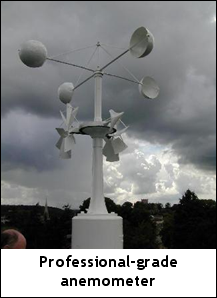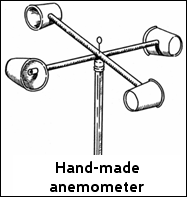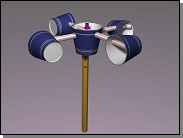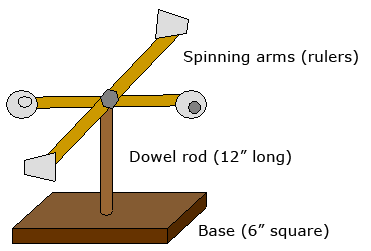This activity is also available in the following formats:
Adobe PDF  Open Document
Open Document  Word Document
Word Document
Making, using, and understanding an ANEMOMETER
OBJECTIVES:
- Construct and use an anemometer
- Investigate wind speed
BACKGROUND INFORMATION:

 An anemometer is an instrument that meteorologists use to measure wind speed. One type of anemometer consists of four arms with cups on the ends that rotate freely. Wind from any direction will catch one of the cups and start the rotation of the arms. The faster the wind is blowing, the faster the arms will spin. To measure the wind speed, students will count the number of times the anemometer makes one complete rotation in 30 seconds. They will multiply this number by 2, giving them the wind speed in rotations per minute (rpm). Without a complicated calibration of the instrument t
An anemometer is an instrument that meteorologists use to measure wind speed. One type of anemometer consists of four arms with cups on the ends that rotate freely. Wind from any direction will catch one of the cups and start the rotation of the arms. The faster the wind is blowing, the faster the arms will spin. To measure the wind speed, students will count the number of times the anemometer makes one complete rotation in 30 seconds. They will multiply this number by 2, giving them the wind speed in rotations per minute (rpm). Without a complicated calibration of the instrument t
hey build, they will not be able to accurately convert their measurements to miles per hour.
PRE-LAB TEACHING STRATEGIES:
Make sure the students understand the purpose of an anemometer. Initiate a discussion on the different things wind speed affects (helps or hurts) in the world.
LAB NOTES:
- Any size wood pieces will work if you do not have a way to cut the strips to a particular size. We recommend wooden rulers because they are a good size, they have a hold in the center, and they are inexpensive. You may substitute any other materials you have available, just be sure that both spinning arms are the same length.
- One cup must be marked “X” or painted so that the students can easily count the revolutions of the instrument.
- Answers to questions in observations: #2) 3 mph #3) 8 mph. Click here to download a Word Document on how to convert rpm to mph.
POST-LAB TEACHING STRATEGIES:
Discuss the importance of making accurate measurements in predicting weather. Discuss the fact that the wind in the upper atmosphere moves at a different speed than the wind on the surface of the earth. Discuss some of the factors that might affect the speed of the wind. Don’t forget to mention the differences in heating and cooling rates of various surfaces such as land and water, and how pressure gradients affect wind speed. Details on all these subjects can be found by entering key words on google.com.
ANEMOMETER

OBJECTIVES:
- To construct and use an anemometer
- To investigate wind speed
MATERIALS:
- 4 paper cups of equal size and shape (rotating cups)
- 1 piece of wood, 15 cm square (or 6 inches) (base of instrument)
- 1 12” long large dowel rod
- two wooden 12” rulers (with a hole in the center), or 12” strips of wood and drill a hole in the center of each (arms of instrument)
- glue
- 2 nails
- 1 washer
- 8 thumb tacks
- tape
- hammer
- red marker or red paint
- stopwatch or clock with a seconds hand
PROCEDURE:
 Nail the wood square to the 12” dowel rod
Nail the wood square to the 12” dowel rod- Glue two wooden rulers together at their centers. The rulers should be glued at a 90º angle to one another. Make sure the holes line up with room to place a nail through them.
- Place a washer between the dowel rod and the rulers and attach the cross to the dowel rod using the remaining nail. The nail should go through the hole in the rulers.
- Use two thumb tacks per cup and attach a paper cup to each end of both rulers.
- Use a red marker or red paint and put a large X on one of the cups.
- Take your anemometer outside and measure the wind speed. To do so, count the number of times the cup with the red mark passes in front of you in 30 seconds. Multiply by two to get revolutions/rotations per minute (rpm).
OBSERVATIONS:
- What was the wind speed?
- If the number of turns made in 30 seconds was 15, what would the wind speed be?
- What would the wind speed be if the anemometer made 40 turns in 30 seconds?
CONCLUSIONS:
- How does the structure of an anemometer allow you to measure wind speed?
- How might your anemometer be less accurate than the ones that weather forecasters (meteorologists) use?
- Are there any structural design flaws that might have decreased the accuracy of the anemometer you built?
- How big does an anemometer have to be to measure wind speed? If you made a bigger anemometer, would the wind speed you measured change? If you made a smaller anemometer, would the wind speed you measured change?